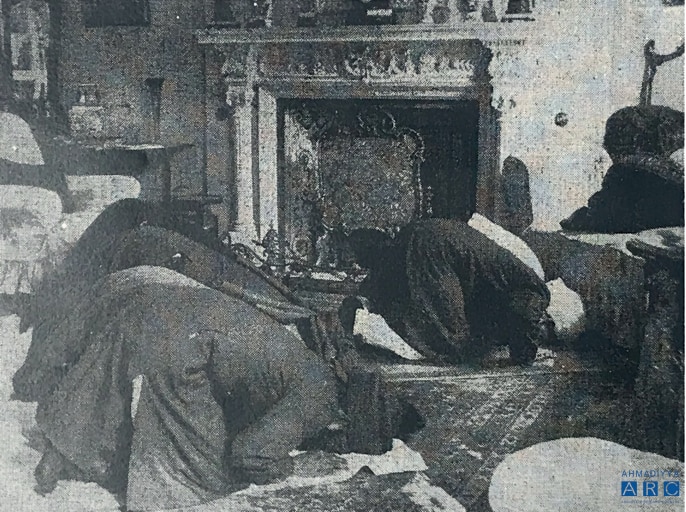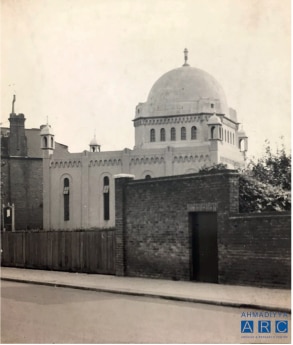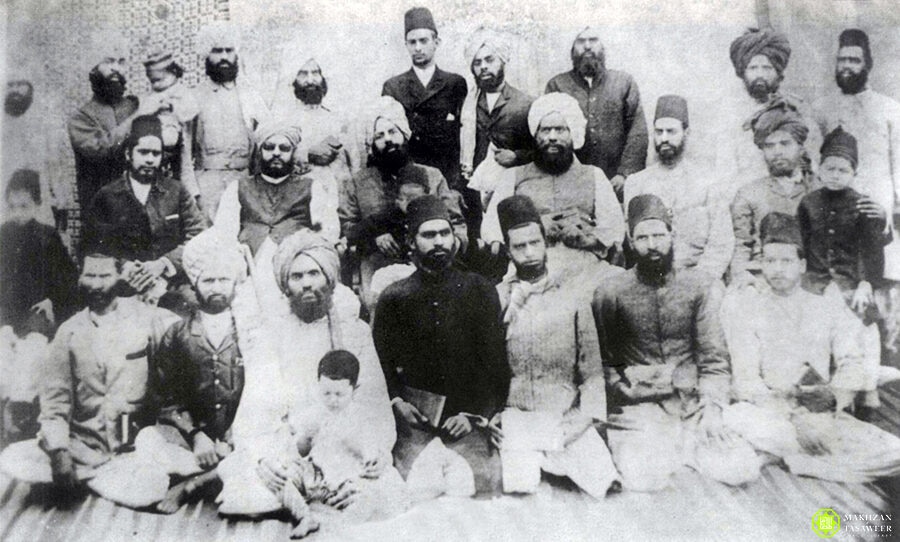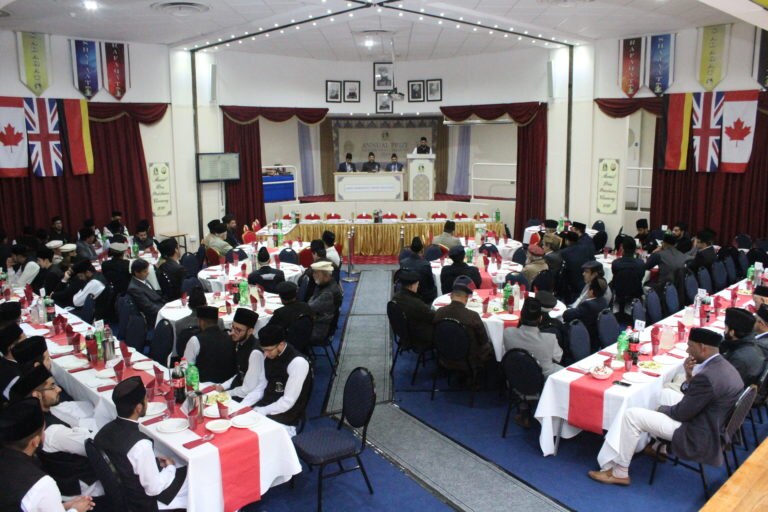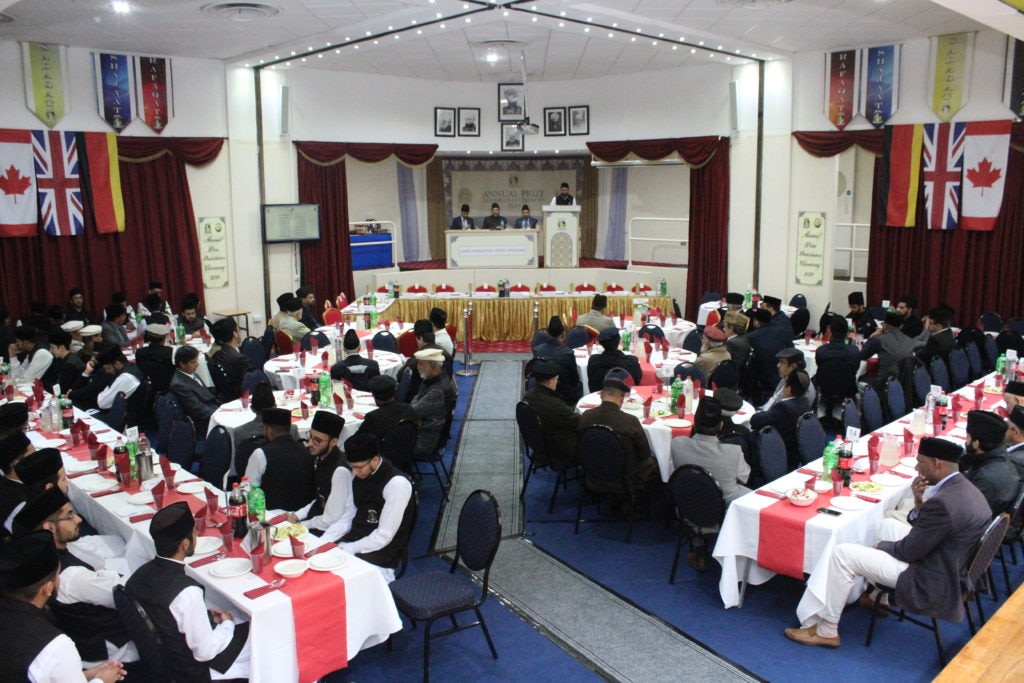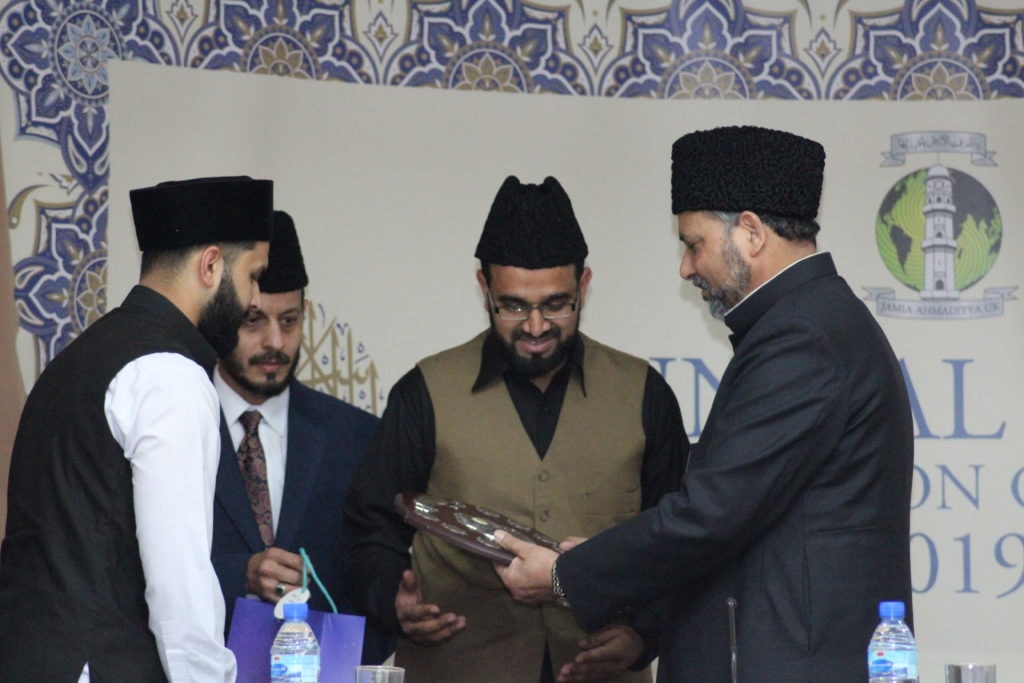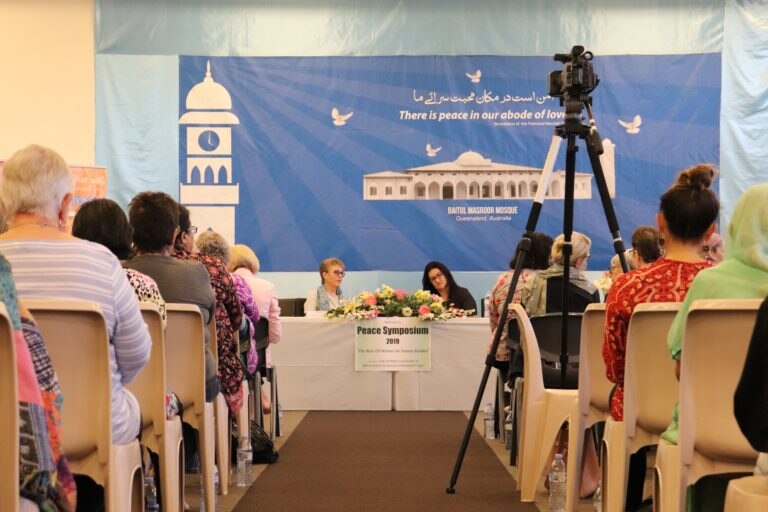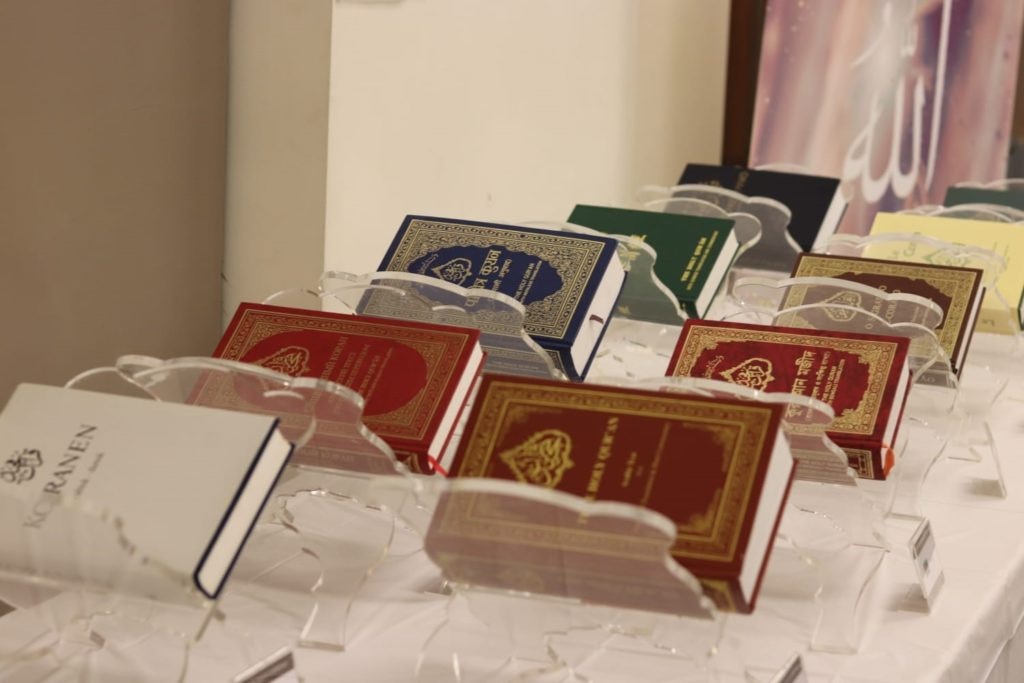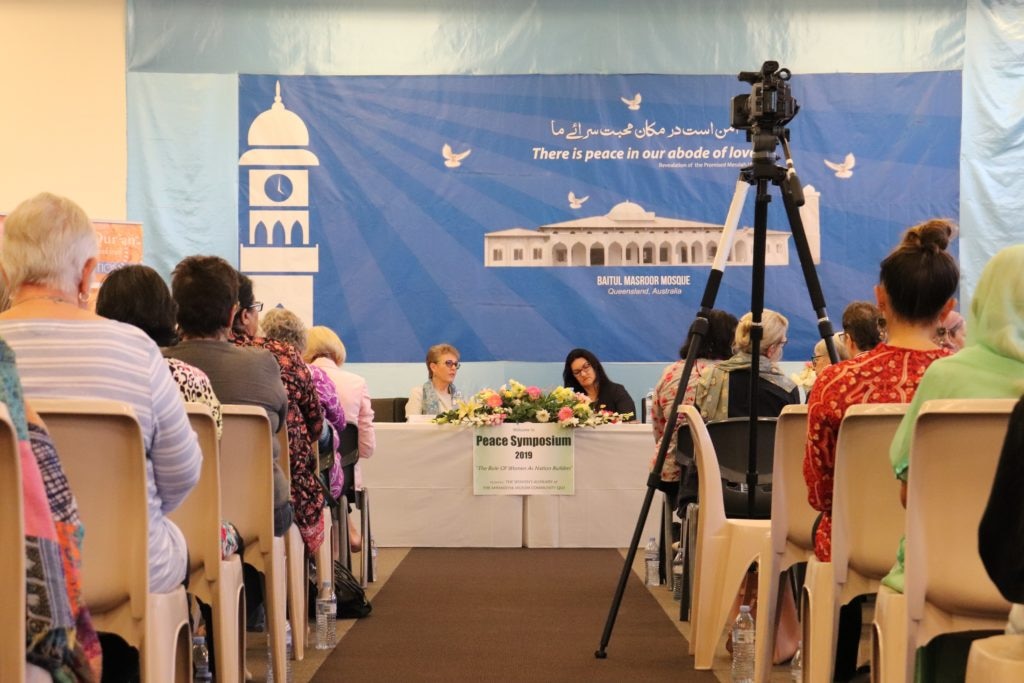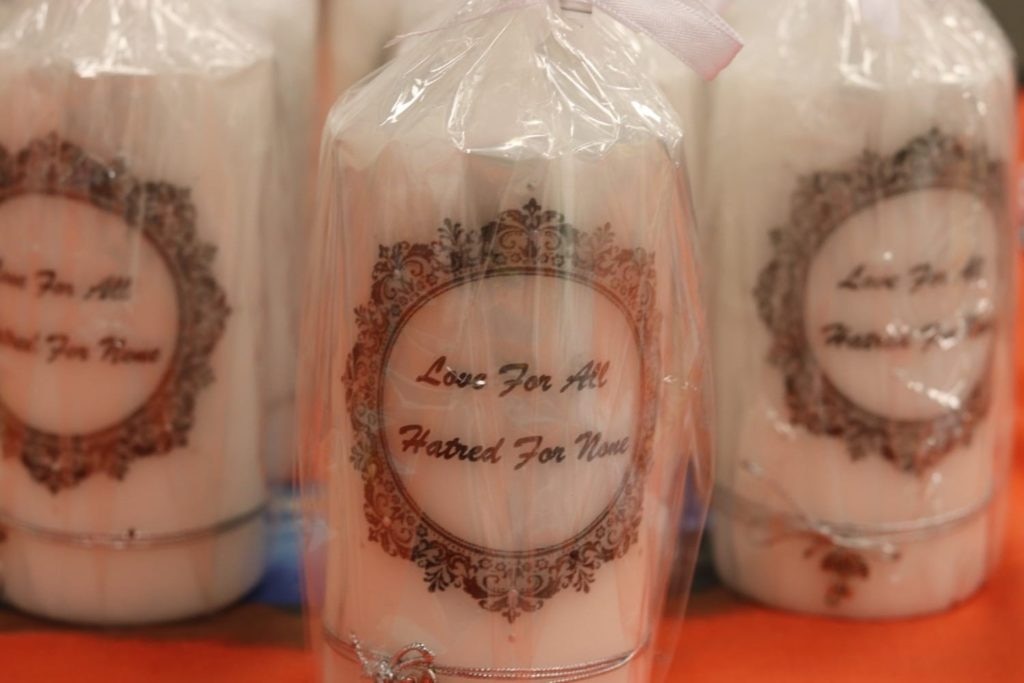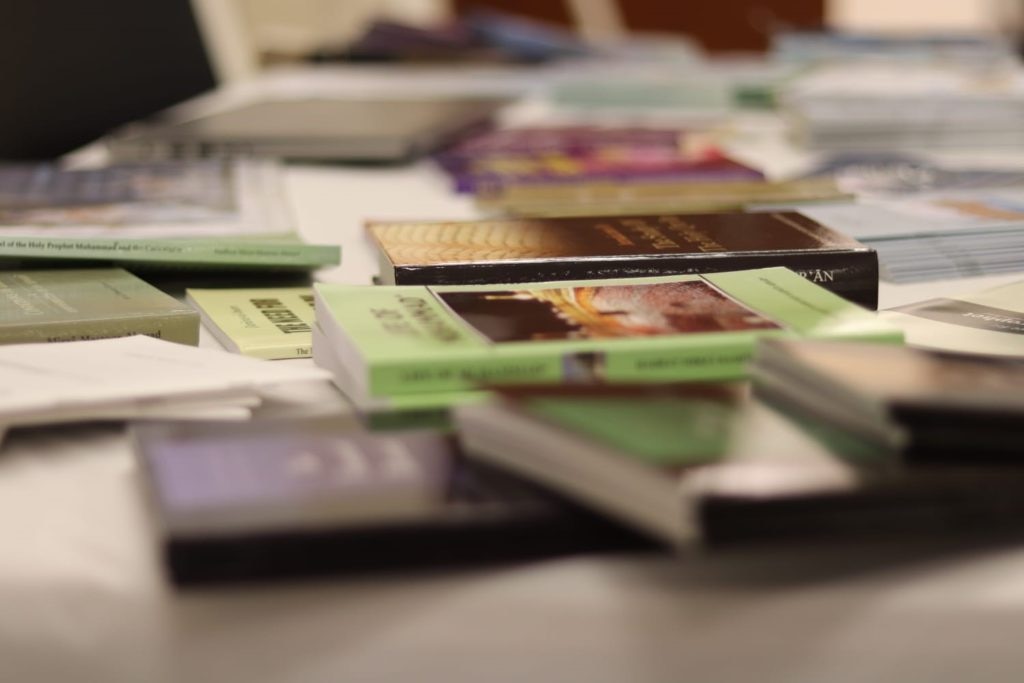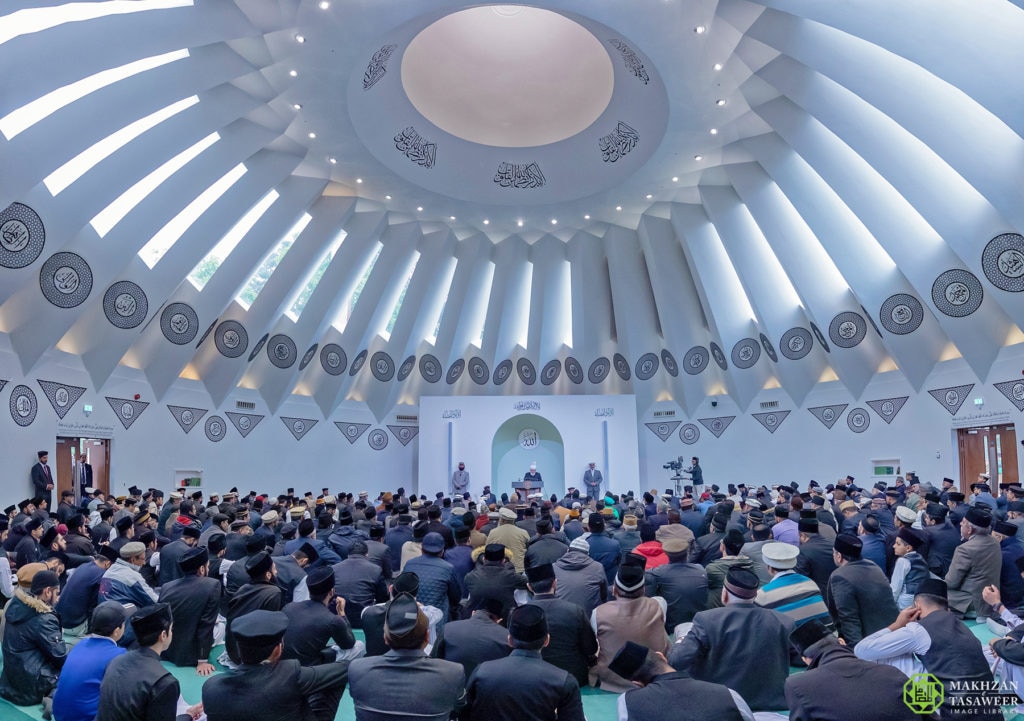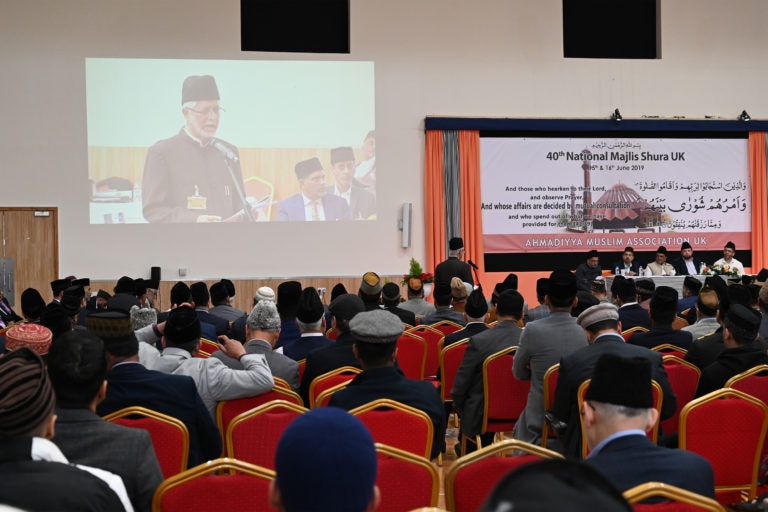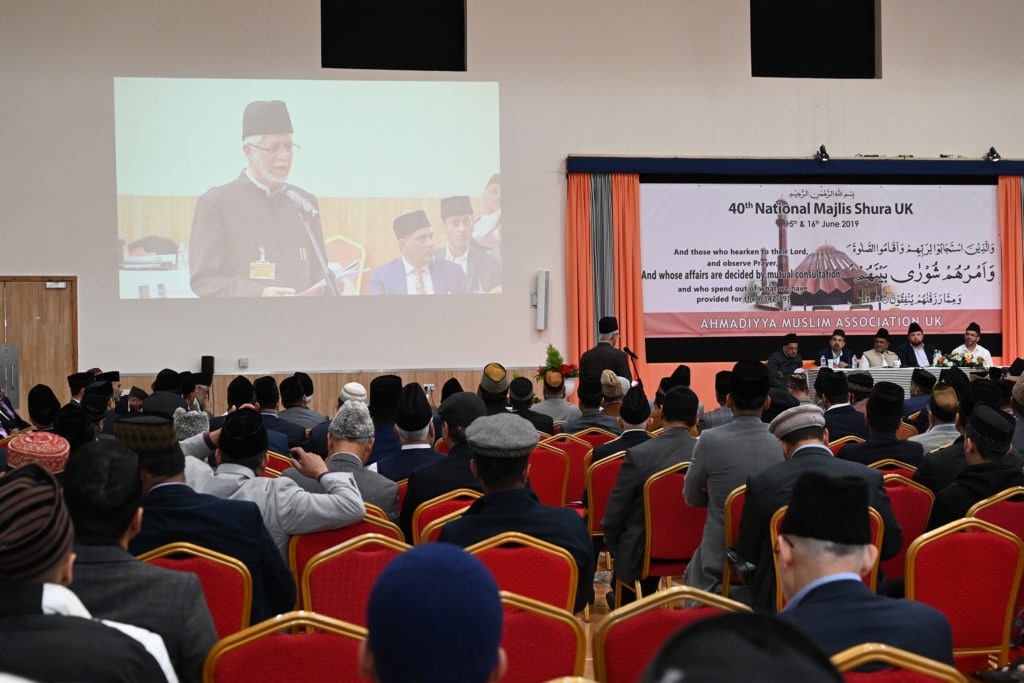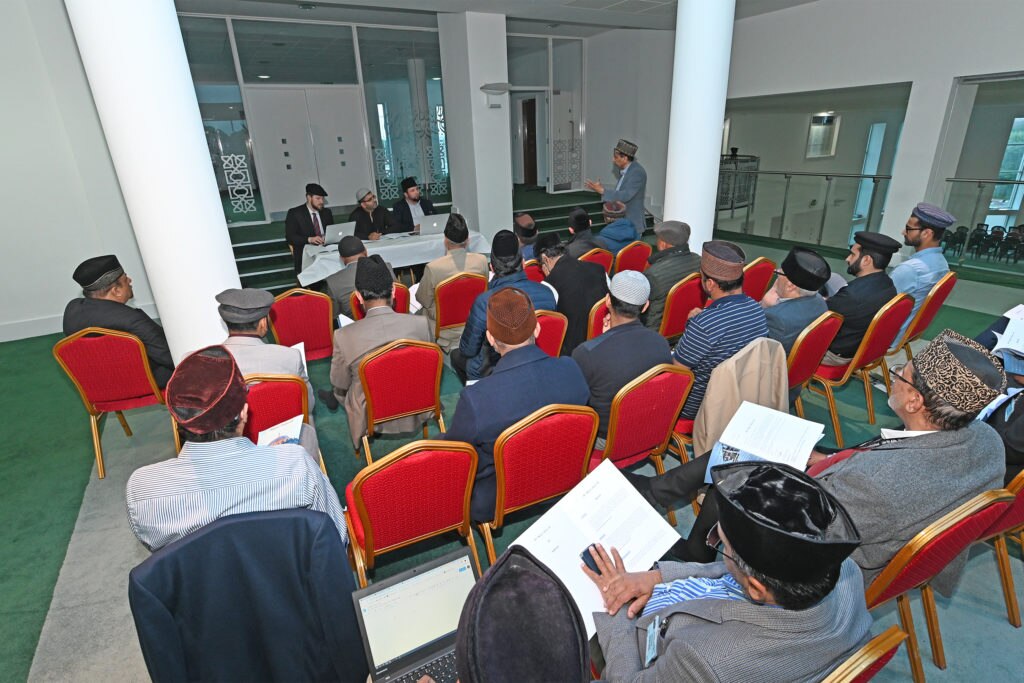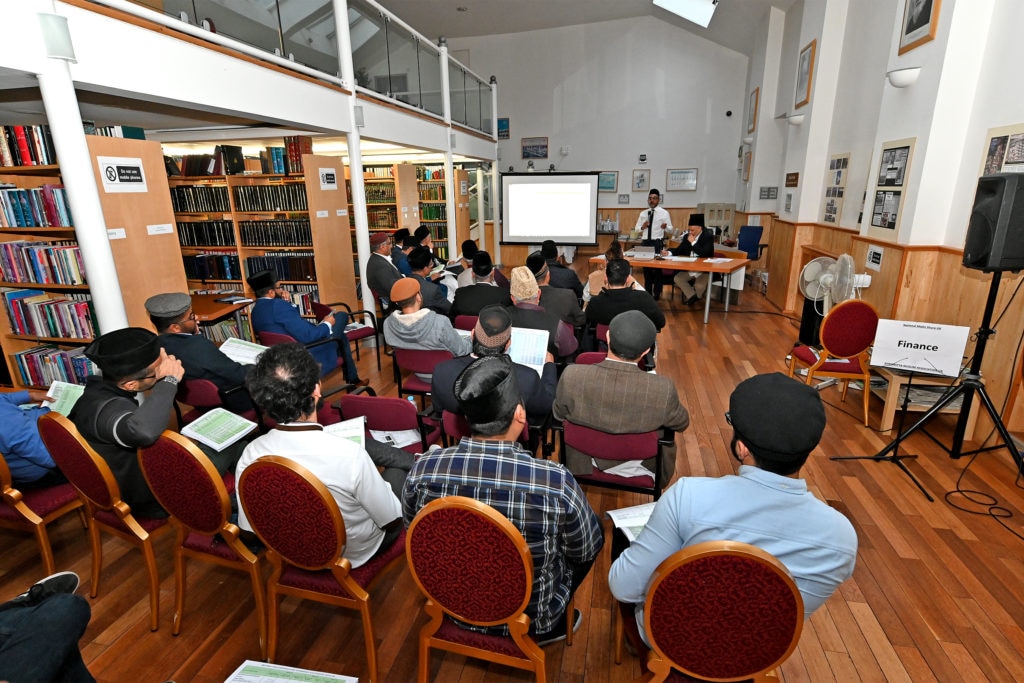Friday Sermon
24 May 2019
Khilafat and Obedience
After reciting the Tashahud, Ta‘awuz and Surah al-Fatihah, Hazrat Khalifatul Masih Vaa recited verses 52-58 of Surah al-Nur and commenced with the sermon:
اِنَّمَا کَانَ قَوۡلَ الۡمُؤۡمِنِیۡنَ اِذَا دُعُوۡۤا اِلَی اللہِ وَ رَسُوۡلِہٖ لِیَحۡکُمَ بَیۡنَہُمۡ اَنۡ یَّقُوۡلُوۡا سَمِعۡنَا وَ اَطَعۡنَا ؕ وَ اُولٰٓئِکَ ہُمُ الۡمُفۡلِحُوۡنَ۔ وَ مَنۡ یُّطِعِ اللہَ وَ رَسُوۡلَہٗ وَ یَخۡشَ اللّٰہَ وَ یَتَّقۡہِ فَاُولٰٓئِکَ ہُمُ الۡفَآئِزُوۡنَ۔ وَ اَقۡسَمُوۡا بِاللّٰہِ جَہۡدَ اَیۡمَانِہِمۡ لَئِنۡ اَمَرۡتَہُمۡ لَیَخۡرُجُنَّ ؕ قُلۡ لَّا تُقۡسِمُوۡا ۚ طَاعَۃٌ مَّعۡرُوۡفَۃٌ ؕ اِنَّ اللہَ خَبِیۡرٌۢ بِمَا تَعۡمَلُوۡنَ۔ قُلۡ اَطِیۡعُوا اللہَ وَ اَطِیۡعُوا الرَّسُوۡلَ ۚ فَاِنۡ تَوَلَّوۡا فَاِنَّمَا عَلَیۡہِ مَا حُمِّلَ وَ عَلَیۡکُمۡ مَّا حُمِّلۡتُمۡ ؕ وَ اِنۡ تُطِیۡعُوۡہُ تَہۡتَدُوۡا ؕ وَ مَا عَلَی الرَّسُوۡلِ اِلَّا الۡبَلٰغُ الۡمُبِیۡنُ۔ وَعَدَ اللہُ الَّذِیۡنَ اٰمَنُوۡا مِنۡکُمۡ وَ عَمِلُوا الصّٰلِحٰتِ لَیَسۡتَخۡلِفَنَّہُمۡ فِی الۡاَرۡضِ کَمَا اسۡتَخۡلَفَ الَّذِیۡنَ مِنۡ قَبۡلِہِم۪ۡ وَ لَیُمَکِّنَنَّ لَہُمۡ دِیۡنَہُمُ الَّذِی ارۡتَضٰی لَہُمۡ وَ لَیُبَدِّلَنَّہُمۡ مِّنۡۢ بَعۡدِ خَوۡفِہِمۡ اَمۡنًا ؕ یَعۡبُدُوۡنَنِیۡ لَا یُشۡرِکُوۡنَ بِیۡ شَیۡئًا ؕ وَ مَنۡ کَفَرَ بَعۡدَ ذٰلِکَ فَاُولٰٓئِکَ ہُمُ الۡفٰسِقُوۡنَ۔ وَ اَقِیۡمُوا الصَّلٰوۃَ وَ اٰتُوا الزَّکٰوۃَ وَ اَطِیۡعُوا الرَّسُوۡلَ لَعَلَّکُمۡ تُرۡحَمُوۡنَ۔ لَا تَحۡسَبَنَّ الَّذِیۡنَ کَفَرُوۡا مُعۡجِزِیۡنَ فِی الۡاَرۡضِ ۚ وَ مَاۡوٰہُمُ النَّارُ ؕ وَ لَبِئۡسَ الۡمَصِیۡرُ
These verses that I have just recited are from Surah al-Nur. It includes the verse relating to Khilafat [Ayat-e-Istikhlaaf], in which God Almighty promised the believers to establish the institution of Khilafat. In the preceding verses and also in the verses that follow after this, they draw one’s attention towards showing obedience to God Almighty and His Messengersa. If these conditions are fulfilled, then God Almighty will fulfil His promise of establishing Khilafat, grant security and peace after our state of fear and He will punish the enemy.
The translation of these verses is as follows:
“The response of the believers, when they are called to Allah and His Messenger in order that he may judge between them, is only that they say: ‘We hear and we obey.’ And it is they who will prosper. And whoso obeys Allah and His Messenger, and fears Allah, and takes Him as a shield for protection, it is they who will be successful. And they swear by Allah their strongest oaths that, if thou command them, they will surely go forth. Say, ‘Swear not; what is required is actual obedience in what is right. Surely, Allah is well aware of what you do.’ Say, ‘Obey Allah, and obey the Messenger.’ But if you turn away, then upon him is his burden, and upon you is your burden. And if you obey him, you will be rightly guided. And the messenger is not responsible but for the plain delivery of the Message. Allah has promised to those among you who believe and do good works that He will surely make them Successors in the earth, as He made Successors from among those who were before them; and that He will surely establish for them their religion which He has chosen for them; and that He will surely give them in exchange security and peace after their fear: They will worship Me, and they will not associate anything with Me. Then whoso is ungrateful after that, they will be the rebellious. And observe Prayer and give the Zakat and obey the Messenger, that you may be shown mercy. Think not that those who disbelieve can frustrate Our plan in the earth; their abode is Hell; and it is indeed an evil resort.”
(Surah al-Nur, Ch.24: V.52-58]
Thus, God Almighty has clearly expounded upon this subject. No matter how often one claims to be a believer, until and unless one follows the commandments of God Almighty and His Messengersa with complete conviction and full certainty and becomes steadfast in the face of every test and trial, one cannot be granted success. Thus, in order to attain true success and triumph, it is incumbent to show complete obedience to God Almighty and His Messengersa. In order to attain the pleasure of God Almighty, it is incumbent to follow His commandments with the fear that lest one may incur the displeasure of God due to some action of his. Likewise, it is incumbent to uphold righteousness. Every good deed and excellent moral needs to be adopted as this is a commandment of God Almighty. When one fulfil these conditions, only then can one attain success and be granted the protection of God Almighty.
When one reflects upon this, they will observe that on many occasions they fail to maintain the standard of obedience which is expected of them – and even in instances where they do act upon something which is against their wishes, they do not do it with the full contention of their hearts. The instruction to obey the commandments of God Almighty and His Messengersa has appeared repeatedly in these verses. These verses pertain to the continuation of the establishment of Khilafat. Thus, in other words, God Almighty is stating that the institution of Khilafat comes under the commandment of showing obedience to God Almighty and His Messengersa. Hence, it is incumbent for one to act upon the directives of Khilafat as this is also among the commandments of God Almighty. In fact, in order to secure the continuation of one’s worldly and spiritual life, it is essential for believers to raise the standard of their obedience.
The Holy Prophetsa has stated, “One who obeys the Amir appointed by me, in fact obeys me and one who obeys me, in fact obeys God Almighty. One who disobeys the Amir appointed by me, in fact disobeys me and my disobedience equates to the disobeying God Almighty.”
(Sahih Bukhari, Kitab-ul-Ahkam, Hadith 7137)
The obedience of the Khalifa of the time however is even more important than the obedience one shows to an ordinary Amir.
We find accounts of complete and absolute obedience in the lives of the companions of the Holy Prophetsa. I will present one such example.
During one of the battles, Hazrat Khalidra bin Waleed was appointed as the leader of the army. However, owing to some reason, Hazrat Umarra replaced him while the battle was at its peak. In any case, the instruction of the Khalifa of the time that came at that occasion was that Hazrat Abu Ubaidahra should take charge. However, Hazrat Abu ‘Ubaidahra initially did not take the charge from Hazrat Khalidra bin Waleed thinking that he was already commanding in an excellent manner. However, Hazrat Khalidra bin Waleed said, “You must immediately take the charge from me because that is the instruction of the Khalifa of the time. I will serve under you with full obedience as you require of me without complaining or any thought of an ill will.”
(Tarikh Tabari, Vol. 2, pp. 356-357)
Thus, this is the standard of obedience required of a believer and it should not be the case that if a decision is made against an individual’s wishes, they begin to object to it. Or, if an office bearer is replaced by another individual, they stop doing their work. Whoever acts in this manner, does not show any obedience and fails to instil the fear of God Almighty and righteousness.
It has now been brought to my attention that there are some presidents [of local Jamaats], who have stopped performing their duties before their actual term ends in June. Since there is a new rule now [where the term officially ends in June] they therefore question why they should now carry on with their duty. However, were they merely performing their duties because they believed that they were permanently going to serve as office bearers? Consequently, they are not paying attention towards the duties they have to perform in the months of May and June.
Firstly, such a thought is a dishonesty of one’s religious obligations. Secondly, it is a rebellious way of thinking and it is a matter that will remove one from the sphere of the obedience towards Khilafat. Since the Khalifa of the time has now approved the rule that the term of a president will only be for six years, therefore, some of them feel that they no longer need to perform their duties wholeheartedly. Hence, such people should act with righteousness and fear God. On one occasion, the Holy Prophetsa took the pledge of initiation on the condition that “we will hear and we will obey, whether we like it or not”. (Sahih al-Bukhari, Kitab-ul-Ahkaam, Hadith no. 7199)
Following this, the Holy Prophetsa said, “Whoever disobeys God Almighty, he will meet Him on the Day of Judgment in a state of not having any argument or excuse for being disobedient”. Furthermore, the Holy Prophetsa states, “The person who dies in a state of not having pledged initiation to the Imam of the age will die a death of ignorance and misguidance”. (Sahih Muslim, Kitab-ul-Imaraa, Hadith 1851)
Hence, we are fortunate to have pledged initiation to the Imam of the age and are not among the ignorant, who have rejected him. However, after having pledged allegiance to him, if we still behave like those who are ignorant, then it will be as if we are removing ourselves from this pledge and we will also be removing ourselves from the sphere of the obedience towards God Almighty and His Messengersa.
Hence, after having pledged initiation, it is extremely important to direct our way of thinking in the right direction and to show examples of complete obedience. What has the Imam of the age said about the standard one ought to acquire after having pledged initiation to him? On one occasion, the Promised Messiahas stated: “A person who makes our teaching his code of conduct and tries his level best to act in accordance with it will be considered to have truly entered the Jamaat. However, one who simply registers his name, but does not act in accordance with the teachings, should remember that God Almighty has intended to make this Jamaat a special Jamaat and an individual, who is not truly a part of this Jamaat, will not remain a member merely by having his name registered in it.” In other words, if one does not act in accordance with this teaching, it is as if one is merely a part of the Jamaat in name only and according to the Promised Messiahas he is not truly part of the Jamaat. The Promised Messiahas further states, “…therefore, you should try your utmost to fashion your deeds in accordance with the teaching that is given to you.”(Malfuzat, Vol. 4, p. 439)
“The teaching is the following that you should not cause any disorder, not commit any evil, show patience in the face of verbal abuse and avoid confrontation.”
That is, one should not confront anyone in idle and vain matters. One should not confront others in the sense that as such and such individual has now been appointed as an office bearer, therefore they will no longer remain obedient or that since they have now been removed from an office, they will no longer obey. The Promised Messiahas further states: “One should treat the one who confronts him with kindness and virtue.” This should be in the case of general, day to day circumstances, as well as in quarrels and disputes. Even if someone confronts others in vain and idle matters, one should try and overlook this fault of theirs. As a matter of fact, one should not only overlook this fault of theirs but treat them with kindness. The Promised Messiahas states, “One should demonstrate an excellent example of speaking to others in a kind manner.” One should speak to others with kindness and in a soft tone and demonstrate a good example. “Comply with each instruction with utmost sincerity of the heart so that you may please God Almighty. Moreover, even your opponent should acknowledge that since taking the Bai‘at, this individual has completely transformed. Be truthful when testifying whilst standing in trial. Those who enter the Community should exert all their efforts and strength to remain truthful.”
(Malfuzat, Vol. 6, p. 413)
Furthermore, God Almighty states that there are some who make a firm oath and claim that if God was to instruct them, they would do such and such. However, when they are instructed to do something, they do not follow through with it. For this reason, God Almighty states that one should not make such great promises and bold claims. In fact, one should simply show ma‘ruf obedience – i.e. what is required is actual obedience in what is right. Even if one was to show such obedience, it would be deemed as fulfilling the commandment. Otherwise, it will be just mere verbal claims and God Almighty is well-aware of one’s deeds as well as the condition of the hearts. Hence, general obedience is that one fulfils the rights due to God Almighty and worship Him in the most excellent manner.
These days during the month of Ramadan, many have acquired a greater focus towards worship, and this should continue to be maintained. Furthermore, this obedience entails that one fulfil the rights of mankind in accordance to the commandments of God Almighty. Also, as I just mentioned that the Promised Messiahas stated that one should safeguard themselves from all kinds of mischief, evil, confrontation and disputes. One should improve the standard of their morals. One’s manners should be such that they show a clear distinction between an Ahmadi and a non-Ahmadi. Always remain steadfast on truthfulness. In short, it is essential to perform all types of virtuous deeds, and this in fact is ma‘ruf obedience, which God Almighty has commanded us to establish. This is what the Holy Prophetsa commanded us and the Promised Messiahas also expressed this desire and instructed the members of his Community to uphold this. Also, Khilafat-e-Ahmadiyya has consistently highlighted the importance towards this for the past 111 years.
This obedience is not only to be shown in religious and spiritual matters, but it is also important to demonstrate perfect examples of obedience in administrative matters as well, just like we find in the example of obedience shown by Hazrat Khalidra bin Waleed. One should not enter into a dispute of whether an instruction is ma‘ruf or not. Indeed, if a directive is against the commandments of God Almighty and His Messengersa, then it is undoubtedly not ma‘ruf.
However, this also does not mean that one should infer from the words of the pledge in which it states: “I shall deem it essential to abide by any ma‘ruf decision made by Khalifatul Masih” that people should now begin to offer their own interpretation and begin to decide what is ma‘ruf and what is not.
When Hazrat Khalidra bin Waleed received the instruction from Hazrat Umarra right at the moment when they were in the middle of the battle and both armies were facing one another – Hazrat Khalidra bin Waleed also possessed great astuteness in the art of war which was proving to be beneficial for the Muslims – but despite this he did not say that this was a non-ma‘ruf order. In fact, he displayed perfect obedience to Abu Ubaidahra and considered it a blessing to serve as an ordinary soldier under his leadership.
Regarding those people who get entangled in the discussion about whether something is ma‘ruf or not, Hazrat Khalifatul Masih Ira stated: “There is another mistake people make and that is in understanding the words ‘to show obedience in ma‘ruf matters.’ Such people do not obey certain instructions that they consider not to be ma‘ruf.” In other words, they decide for themselves as to what is ma‘ruf and what is not. Hazrat Khalifatul Masih Ira further states, “The word ma‘ruf has also been used for the Holy Prophetsa as well:
وَلَا یَعْصِیْنَکَ فِیْ مَعْرُوْفٍ
‘nor disobey thee in what is right’ (Surah al-Mumtahanah, Ch.60: V.13).”
Hazrat Khalifatul Masih Ira states: “Have such people prepared a list consisting of the Holy Prophet’ssa faults?”
Did they make some kind of list for his short-comings and weaknesses, God forbid, whereby one could ascertain as to which of his decisions were ma‘ruf and which were not? Hazrat Khalifatul Masih Ira states, “Likewise, Hazrat Sahib”, i.e. the Promised Messiahas “has also included the obedience of all ma‘ruf decisions in the conditions of Bai‘at. There is a deep underlying wisdom in doing so.”
(Haqaiq-ul-Furqan, Vol.4, pp. 75-76)
This is because the prophets and the Khulafa instruct only according to the commandments given to them by God Almighty. On one occasion, whilst explaining the word ma‘ruf , the Promised Messiahas stated that a prophet commands that which is in line with reason and he forbids all that which goes against logic. He deems pure things lawful and all impurities unlawful. God Almighty has clearly stated all of these in the Holy Quran and the Holy Prophetsa has also explained all the commands and prohibitions, i.e. the acts we should carry out and those we should abstain from. Thus, those who follow Allah and His Messengersa and act upon all these commandments will attain salvation. Therefore, we must always remember that the instructions given by Khilafat are, and will continue to be so, in accordance to the Shariah and Sunnah. God Almighty has stated that if you obey, you shall be rightly guided and there is no other path besides this which leads to salvation. God Almighty then states that He has promised those who believe and do good deeds that Khilafat shall remain with them. Good deeds is not only that one turns all their attention to prayer, are sincere in their worship of God Almighty, abstain from all kinds of shirk [associating partners with God]; not just outward shirk but also to pursue your vain desires and to give faith secondary importance is also shirk; no doubt these are very pious deeds, but in addition to this, to demonstrate obedience is also very important.
Hence, if we wish to truly benefit from the promise of the blessings of Khilafat, we must not only safeguard our prayers and stay away from shirk, but it is also incumbent that we obey the Khalifa of the time, otherwise we shall be counted among the disobedient, just as the Promised Messiahas stated that they will not truly be deemed among his adherents. God Almighty states that the Jamaat of believers, who remain firmly attached to Khilafat, also pay attention to observing prayer, populate the mosques, give Zakat, make financial sacrifices for the sake of Allah and His Messengersa and who follow the commands of God Almighty and the practice of the Holy Prophetsa to the best of their ability. When this condition is developed, God Almighty will have mercy on such servants.
Therefore, in order to attract the mercy of God Almighty, we must improve our condition and when the mercy of God Almighty covers us in His cloak of rahmaniyyat and rahimiyyat, all the plots and schemes of the opponents will come to naught and they shall come to a miserable end, God-willing. Hence, if we are to attract the favours of God Almighty, we must analyse ourselves as to what extent we possess obedience, are acting upon the commandments of God Almighty, are adorning our prayers, are trying to follow the practice of the Holy Prophetsa and what our level of obedience is. We should reflect upon our conditions in this regard.
I will now present some incidents relating to Hazrat Musleh-e-Maudra which he narrated at various occasions. He mentioned about the precarious times after the demise of the Promised Messiahas and how the institution of Khilafat granted peace and security. With regard to those who refused to perform the Bai‘at, he has narrated about their lives before the second Khilafat and how they acted after the election took place. Hazrat Musleh-e-Maudra has also written about their line of thinking before the second khilafat and after.
When the Promised Messiahas passed away, the enemies [of Ahmadiyyat] were rejoicing. However, with the election of Hazrat Khalifatul Masih Ira, they expressed dejection and embarrassment. Subsequently, when Hazrat Khalifatul Masih Ira passed away, the enemies of Ahmadiyyat hoped then that the Jamaat would be destroyed. But once again, God Almighty safeguarded the Jamaat of the believers and changed the atmosphere of fear into peace and tranquillity. These historical accounts are vital to strengthen the faith of the youths as well as of those who are unaware of them. They are also important because everyone should be aware of the events in history to a certain extent. I will present these accounts before you.
Hazrat Musleh-e-Maudra has written that after the demise of the Promised Messiahas, their condition was the same as that of the Muslims at the demise of the Holy Prophetsa. Hazrat Musleh-e-Maudra writes:
“The Ahmadiyya Jamaat was in the same state of mind during the lifetime of the Promised Messiahas as were the Companionsra of the Holy Prophetsa during his lifetime. All of us believed that the Promised Messiahas would not die as yet. As a result, we never thought, even for a moment, about what would happen after his demise. I, at that time, was not a child. I was a young man, I used to write articles, and was editor of a magazine. I say on oath that I never thought, for a minute, or even for a second, that the Promised Messiahas would die, even though in the last years of his life, there were a series of revelations about his demise. In his last days, such revelations increased manifold. Despite the fact that there were revelations and visions specifying the date etc. of the demise of the Promised Messiahas, and we used to read Al-Wasiyyat (The Will), we still presumed that these things would probably happen after two centuries. Thus, the thought of what would happen after the demise of the Promised Messiahas never crossed our minds.
“Since we had assumed that he would not die in our lifetime, it was difficult for us to accept the reality of his demise when it happened. I clearly remember that after his demise, he was given a bath and was wrapped in the shroud. As is common, that one’s clothes and moustache etc. move with the blowing of the wind, some of the companions would come running, saying that the Promised Messiahas was alive, and his clothes or moustache was moving. Some said that they saw his shroud moving. Anyhow, the body of the Promised Messiahas was brought to Qadian and was placed inside a house in a garden.”
After describing their condition upon the demise of the Promised Messiahas, Hazrat Musleh-e-Maudra further states:
“Around eight or nine o’clock, Khawaja Kamaluddin Sahib arrived in the garden, took me aside, and asked me, ‘Mian! Have you thought of what would happen after the demise of the Promised Messiahas?’ I replied to him, ‘Something should happen, but as to what it should be, I cannot say anything.’
“He said to me, ‘In my opinion, we should give Bai‘at to Hazrat Maulvi Sahib (Hazrat Khalifatul Messiah Ira)’. At that time, due to my age and lack of knowledge, I said, ‘The Promised Messiahas did not mention anywhere that we should take the Bai‘at of someone after him, so why should we take the Bai‘at of Hazrat Maulvi Sahibra?’”
Hazrat Musleh-e-Maudra further says:
“Though it was mentioned in Al-Wasiyyat, however it did not occur to me at that time.”
He further writes:
“On this, Khawaja Kamaluddin Sahib started arguing that the Community would be destroyed if the Bai‘at was not taken at the hand of one person. He added that after the demise of the Holy Prophetsa, the people took the Bai‘at of Hazrat Abu Bakrra…”
This point raised by Khawaja Kamaluddin Sahib is of great significance. He said that after the demise of the Holy Prophetsa, the Muslims pledged allegiance to Hazrat Abu Bakrra and accepted him as the Khalifa. Khawaja Sahib then further adds:
“So the same should be done now, and there is no one more suitable in the Jamaat than Hazrat Maulvi Sahib [Hazrat Khalifatul Messiah Ira].”
Hazrat Musleh-e-Maudra further writes that Maulvi Muhammad Ali Sahib was of the same opinion, rather it was Khawaja Kamaluddin Sahib who informed Hazrat Musleh-e-Maudra that Maulvi Muhammad Ali Sahib also held the same opinion that the Jamaat should pledge allegiance at the hands of Hazrat Maulvi Sahibra.
Hazrat Musleh-e-Maudra writes:
“Finally, the whole Community unanimously requested Hazrat Khalifatul Masih Ira to accept the Bai‘at of the people. Then, all the people gathered in the garden and Hazrat Khalifatul Masih Ira addressed them and said, ‘I have no wish for imamat [leadership], and in my opinion, the Bai‘at of someone else should be taken’. For this purpose, he first proposed my name, then the name of our maternal grandfather, Mir Nasir Nawab Sahib, then the name of our brother-in-law, Nawab Muhammad Ali Khan Sahib, and then the names of some other people, but we all unanimously told him that he himself was entitled to the post of Khilafat. Then, everyone took Bai‘at on his hand.” (Khilafat-e-Rashida, Anwar-ul-Ulum, Vol.15, pp. 489-491)
Furthermore, according to some narrations, Khawaja Kamaluddin Sahib published an announcement in which he stated that in light of the book, Al-Wasiyyat, they ought to elect a Khalifa who is to be obeyed in full and even presented the name of Hazrat Khalifatul Masih Ira.
Nonetheless, this was their thinking initially and perhaps this was after assessing the situation and in order to achieve their underlying goal. Although these people pledged allegiance to Hazrat Khalifatul Masih Ira, in reality, they lacked true obedience to Khilafat and were devoid of the true spirit of pledging allegiance. Deep down they had other ideas and were always scheming how they could impose the authority of the [Sadr] Anjuman over Khilafat, thereby gaining complete control to govern through the Anjuman. This was the thinking of those individuals. Mentioning about their intentions, Hazrat Musleh-e-Maudra writes:
“About 15 to 20 days after the Bai‘at (of Hazrat Khalifatul Masih Ira), Maulvi Muhammad Ali Sahib met me and said, ‘Mian! Have you ever considered how the organisation of the Community would function?’ I replied, ‘What is the point of pondering over this issue, for we have taken Bai‘at at the hand of Hazrat Maulvi Sahibra’. On this, he said, ‘This is the relationship between a ‘pir’ [spiritual mentor] and ‘murid’ (follower of a spiritual mentor), and the question remains, how will the organisation of our Jamaat operate?’ I said, ‘I do not see this matter worthy of discussion, as we have taken the Bai‘at of one person, and he can better explain which type of system should be established in the Jamaat, and there is no need for us to interfere in this matter.’ He stopped his argumentation but added that the point required further consideration.” (Khilafat-e-Rashida, Anwar-ul-Ulum, Vol.15, p. 491)
He [Maulvi Muhammad Ali Sahib] was not content. From these incidents one can gauge their internal condition. It shows that they did not perform the Bai‘at at the hands of Hazrat Khalifatul Masih Ira wholeheartedly, rather they had an agenda. For this reason, they were never at peace and were always anxious. They failed to develop that peace within them that God Almighty has promised to bestow upon those who forge a connection with Khilafat. They refused to show complete obedience and wished to run this spiritual institution in the way a worldly organisation would be run. We are a witness to their outcome; they exist merely by name and are a handful, perhaps a few hundred followers. In fact, it is appropriate to say they are only a handful who follow their self-made organisation. On the contrary, those who remain under the shade of Khilafat, by the grace of Allah, they are now established in 212 countries of the world.
Then explaining about what the enemies thought regarding the future of the Jamaat after the demise of the Promised Messiahas, Hazrat Musleh-e-Maudra says that when the Promised Messiahas passed away, people generally thought that the community would perish. The enemies were jubilant and thought that people would stop paying Chanda – as they thought that people only paid this because of the Promised Messiahas – and as a result the progress of the Jamaat would stop. However, when people witnessed that the Jamaat was continuously progressing in terms of its numbers, sacrifices and propagation of the faith, they concocted that Maulvi Nuruddin Sahib was a renowned scholar in the Jamaat and the entire progress of the Jamaat was owing to his efforts and even during the lifetime of Mirza Sahib [i.e. the Promised Messiahas], he did most of the work but would attribute it all to Mirza Sahibas. In fact, Hazrat Musleh-e-Maudra states that many people, whose nature and disposition is similar to that of the Maulvis and only have regard for superficial things, would say even during the lifetime of the Promised Messiahas that the community was in fact being run by Maulvi Nuruddin Sahib. Thus, when they witnessed that the Jamaat was progressing even more than before during the time of Maulvi Sahib, the Maulvis completely retracted from their initial claims and instead began to rejoice at the fact that they were right when they said that everything was being done by Maulvi Nuruddin Sahibra. They claimed that a proof of this was that despite the demise of the Promised Messiahas, it had no impact whatsoever upon the Jamaat. They claimed that the Jamaat was being run owing to the efforts of Hazrat Maulana Nuuruddin Sahibra alone.
(Khutbat-e-Mahmud, Vol. 21, p. 413)
In relation to a particular Maulvi, Hazrat Musleh-e-Maudra states: “Some members from Gujrat told me that when the Promised Messiahas passed away, an Ahl-e-Hadith Maulvi told them, ‘You are now trapped because the Holy Prophetsa stated that after prophethood, the institution of Khilafat is established. You claim the Promised Messiah is a prophet, but irrespective of whether he is a non-law bearing prophet or attained the status of prophethood through his subservience to the Holy Prophetsa, prophethood is succeeded by Khilafat and you will not have Khilafat. You follow the values of the English, therefore will not seek to establish Khilafat.’ The Ahmadi member from Gujrat further stated that the next day they received a telegram.”
Nowadays we have the internet and phones and news can be conveyed in a matter of seconds, however in those days they would send information through post office via telegram. At times, it could take up to two to three days to receive a telegram post.
“The telegram contained the news that the Jamaat had taken the Bai‘at [pledge of allegiance] at the hands of the Hazrat Maulvi Nuruddin Sahibra
